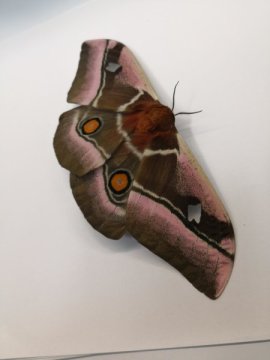[ad_1]
Moths are a mainstay food source for bats, which use echolocation (biological sonar) to hunt their prey. Scientists such as Thomas Neil, from the University of Bristol in the U.K., are studying how moths have evolved passive defenses over millions of years to resist their primary predators.
While some moths have evolved ears that detect the ultrasonic calls of bats, many types of moths remain deaf. In those moths, Neil has found that the insects developed types of “stealth coating” that serve as acoustic camouflage to evade hungry bats.
Neil will describe his work during the Acoustical Society of America’s 176th Meeting, held in conjunction with the Canadian Acoustical Association’s 2018 Acoustics Week, Nov. 5-9 at the Victoria Conference Centre in Victoria, Canada.
In his presentation, Neil will focus on how fur on a moth’s thorax and wing joints provide acoustic stealth by reducing the echoes of these body parts from bat calls.
“Thoracic fur provides substantial acoustic stealth at all ecologically relevant ultrasonic frequencies,” said Neil, a researcher at Bristol University. “The thorax fur of moths acts as a lightweight porous sound absorber, facilitating acoustic camouflage and offering a significant survival advantage against bats.” Removing the fur from the moth’s thorax increased its detection risk by as much as 38 percent.
Neil used acoustic tomography to quantify echo strength in the spatial and frequency domains of two deaf moth species that are subject to bat predation and two butterfly species that are not.
In comparing the effects of removing thorax fur from insects that serve as food for bats to those that don’t, Neil’s research team found that thoracic fur determines acoustic camouflage of moths but not butterflies.
“We found that the fur on moths was both thicker and denser than that of the butterflies, and these parameters seem to be linked with the absorptive performance of their respective furs,” Neil said. “The thorax fur of the moths was able to absorb up to 85 percent of the impinging sound energy. The maximum absorption we found in butterflies was just 20 percent.”
Neil’s research could contribute to the development of biomimetic materials for ultrathin sound absorbers and other noise-control devices.
“Moth fur is thin and lightweight,” said Neil, “and acts as a broadband and multidirectional ultrasound absorber that is on par with the performance of current porous sound-absorbing foams.”
Story Source:
Materials provided by Acoustical Society of America. Note: Content may be edited for style and length.
[ad_2]















